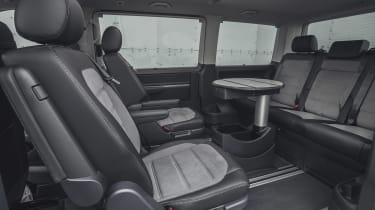Volkswagen Caravelle (2015-2022) review - Practicality, comfort and boot space
The Caravelle’s core strength is the sheer amount of space inside it but clever design helps you make the most of all the room too

The basic VW Caravelle cabin layout is the same across the range. You get a pair of fixed, forward facing seats in the front, then two rotating arm chairs in the middle row and a 3-seat bench making up the third row. Sitting in the middle is a multi-function table that folds out and contains various cup holders and storage options. With all of the second and third row elements mounted on sturdy rails cut into the Caravelle’s floor, they can be slid back and forth to configure the cabin in various different ways and give the Caravelle its outstanding flexibility.
Size
This is a large vehicle by passenger car standards. Short wheelbase derivatives are 4,904mm long and the long wheelbase ones stretch to 5,304mm. All Caravells are 2,297mm wide from door mirror tip to door mirror tip and just shy of 2 meters tall. In terms of weight, the heaviest 4Motion 4x4 models are 2,495kg and even the lightest model in the range is 2,330kg.
Leg room, head room & passenger space
Space is never in short supply in a Caravelle. The driving position is very high and with a height adjustable seat you can get a great view out of the vehicle, no matter how tall you are. Headroom is abundant in all the seats and there’s a real feeling of spaciousness that passenger carrying vehicles without commercial vehicle origins simply can’t match.
Moving the rear seats around on their rail system is simple enough but they are extremely heavy so it’s not advisable to try and lift them out of the car single handed. The central table can also get in the way when you’re trying to move the seats so you soon learn to shift this out of the way first.
Used - available now

2023 Land Rover
Defender 90
8,047 milesAutomaticDiesel3.0L
Cash £61,960
2023 Mercedes
GLA
28,116 milesAutomaticDiesel2.0L
Cash £28,760
2022 BMW
X1
33,509 milesAutomaticPetrol2.0L
Cash £23,700
2022 BMW
3 Series
48,218 milesAutomaticDiesel3.0L
Cash £28,500Access to the rear is via the powered sliding side doors that open very wide even in the tightest of spaces. It means that there’s absolutely no problem climbing into the third row seats, unlike in most other 7-seater passenger cars.
Boot
The Caravelle’s boot space depends on your choice of short or long wheelbase and on how you’ve chosen to configure the interior. The beauty of the rail-based seating system is that you can sacrifice boot capacity for more legroom or visa versa. As we’ve said, the seats don’t fold flat to the floor but you can fold the seat backs down or lift the seats out entirely, returning the Caravelle to a van-like configuration with a huge load area. You can carry payloads of between 587kg and 670kg depending on the model. In terms of actual boot volume though there are some things to be aware of. Loading couldn’t really be easier thanks to the huge slab-like tailgate and the low loading floor but bear in mind that you’ll need a lot of space behind the vehicle to get that tailgate open.
In addition, particularly in the short wheelbase models, the luggage space behind the rear seats is very shallow. You’ll need to stack luggage up to get large amounts inside and then you risk it toppling out when you reach your destination and open the tailgate. Ultimately though, if you want to carry 7 adults and luggage, there’s little short of a full-blown minibus to touch the Caravelle.
Towing
If the interior space is insufficient, you can always hitch up a trailer and pull some extra capacity along behind. All versions of the Caravelle can tow a 2,500kg brakes trailer - or a 750kg unbraked one.








